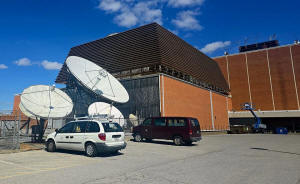Billions were pledged, but many Illinois university construction
projects stalled
[March 25, 2025]
By Ryan Grieser and The Saluki Local Reporting Lab
Buildings on Illinois’ college campuses were falling apart when
lawmakers approved $2.9 billion for higher education construction as
part of the 2019 Rebuild Illinois capital plan. The funding brought hope
for long-overdue upgrades, but the slow rollout has left colleges in
limbo.
Five years later, half of the 16 promised projects are still tied up in
planning.
“It’s been slow, and it’s been frustrating at times,” said Matt Bierman,
vice president of business affairs at Eastern Illinois University, which
is planning to build a new science building with its funding.
A series of setbacks have stalled progress, including staffing issues at
the Capital Development Board, the state’s construction management
agency, rising post-pandemic construction costs and local disputes over
how to stretch funding that no longer covers what university officials
originally planned.
Construction costs shot up nearly 40% by 2023 compared with pre-pandemic
levels, according to Associated Builders and Contractors.
“We lost about $30 million in buying power,” said Mark Luer, dean of the
College of Pharmacy at Southern Illinois University Edwardsville. “We
just couldn’t get everything we wanted in the original concept.”
SIUE was able to build its Health Sciences Building, but it came with
major changes to the original plan.
“We started making tradeoffs, like, ‘Well, we really need this. If we’re
going to cut back, let’s cut back in these areas,” Luer said.

SIU Carbondale faced a similar problem with plans to fully renovate its
1960s-era Communications Building on the Carbondale campus with roughly
$85 million allocated from Rebuild Illinois. By the time they set out to
finalize the design, officials no longer had enough funds to do what
they’d originally planned. SIU leaders initially had asked lawmakers for
additional money, but when it didn’t come, they started moving forward
with a scaled-down design, according to Hong Cheng, dean of the College
of Arts and Media.
Lately, state officials have sought to provide some relief. The Illinois
Board of Higher Education’s 2025 budget included $575 million to help
schools affected by rising costs see their projects to fruition. For
2026, the board is urging lawmakers to carry over any unspent funds and
speed up project approvals to ensure those under Rebuild Illinois are
completed within the six-year timeframe, according to IBHE spokesperson
Jose Garcia.
Promises to ‘beef up’ staff
The state itself has also faced challenges to completing these projects.
The Capital Development Board oversees all major projects to ensure
contractors, designers and builders stay within budget and meet state
requirements. But the agency’s staff has been overwhelmed by the surge
of projects created under Rebuild Illinois.
“There’s a lot of projects … and they can’t be accomplished all at once,
because it’s got to go through the CDB,” said Bierman, the EIU
administrator. The university has faced delays in redesigning its
planned new science building to match the new funding reality, in part,
because the state lacks the resources to move quickly, Bierman said. He
expects EIU to complete the project by 2029 — a decade after the state
passed Rebuild Illinois.
The agency reported in 2023 that many projects fell behind schedule due
to a wave of retirements, according to a public accountability report on
the Illinois comptroller’s website.
Tamakia Edwards, who was appointed executive director of the Capitol
Development Board in May after the retirement of her predecessor, said
in an interview she and her staff are looking for ways to ensure
projects stay on track. That includes efforts to “beef up” the agency’s
current workforce of about 160 who oversee all legal, financial and
planning aspects of hundreds of projects.

“We have 658 (projects), in all phases of project delivery,” Edwards
said. “We’re constantly looking at process improvements, how to do
things better and faster, and how to mitigate risk. Those are constant
conversations I’m having with our team.”
The pandemic created workforce challenges, she said. But Edwards
cautioned that even under the best circumstances, projects take a long
time to complete.
[to top of second column]
|

The SIU Communications Building is scheduled for a major renovation
through the Rebuild Illinois program, but work has yet to begin amid
ongoing delays. (Capitol News Illinois photo by Molly Parker)

“It’s not like funds are appropriated on Monday and then we’re out the
gate in 30 days doing the project,” she said. “There are also unforeseen
challenges and design and scope development and prioritization changes.
There’s a lot of things that are happening behind the scenes throughout
the lifecycle of a project.”
Edwards noted that while the project-planning process can often be
lengthy, construction has been moving quickly once projects go to bid.
Luer, who is overseeing the project at SIUE, found this to be true.
“The pandemic slowed the design phase of it, but it didn’t slow the
construction,” Luer said. “Once we got to the point of putting it out
for bid, it all moved really quickly.”
Luer said he anticipates SIUE’s construction to wrap up this spring, and
for the building to host its first classes with the start of the fall
semester in August. The SIUE School of Pharmacy, which has been in
temporary facilities since its formation in 2004, will finally have a
home once the new building opens. Luer said it’s been a long haul and he
and others on the Edwardsville campus are eager for the project’s
completion.
“I’m just looking forward to what we can imagine we’re going to be able
to do with facilities that were actually designed for the purposes that
we’re going to be able to use them for,” Luer said.
Shifting priorities
Southern Illinois University Carbondale and Eastern Illinois University
will have to wait several more years for their projects to become
reality. SIU Carbondale will receive nearly $15 million in addition to
its original $84 million allocation for the Communications Building.
Officials see that as good news, but it also means more design work —
and further delays.
While Bierman said EIU is grateful for the project, it’s also been a
challenging process. Nearly a quarter century will have passed by the
time officials expect construction on the science building to wrap up.
“I don’t know how much longer they’re going to stay ahead of the curve
in terms of getting something designed that’s going to meet today’s
needs,” Bierman said.

Bierman said the process for requesting state funding for building
renovations and repairs isn’t flexible. Once a project is identified as
a priority, he said, it’s difficult to change plans. While universities
can shift priorities before selection and appropriation, they can’t
reallocate funds from one project to another.
Going forward, EIU hopes to focus on renovating existing spaces rather
than building new ones. He also urged state lawmakers to provide more
consistent state capital funding for universities, rather than focusing
their efforts on only a few large-scale projects.
According to IBHE data, public universities across Illinois face more
than $8.3 billion in deferred maintenance. This backlog of neglected
repairs — leaks, mold remediation, heating and cooling repairs, and
other issues that worsen as aging buildings deteriorate — has nearly
tripled over the past two decades.
While many buildings at state universities hold historical value,
officials say they are becoming obstacles to recruitment. Declining
enrollment and budget shortfalls make it harder to maintain aging
buildings, creating a vicious cycle.
“We want renovation dollars. We want to fix what we have, instead of a
building that somebody can put a shovel in the ground for a press
release. We want something that’s practical,” Bierman said.
Edwards, of the Capital Development Board, acknowledged the “reality” of
the aging infrastructure, and said there is near constant discussion and
strategizing about how to address the problem.
“We have some rich history in our buildings across the state, and we
want to preserve that history and take care of our assets,” she said.
Ryan Grieser is a journalism student at Southern
Illinois University Carbondale. This story was produced for Capitol
News Illinois through the Saluki Local Reporting Lab, supported by
grant funding from the Pulitzer Center and the Illinois Press
Foundation.
Capitol News Illinois is
a nonprofit, nonpartisan news service that distributes state
government coverage to hundreds of news outlets statewide. It is
funded primarily by the Illinois Press Foundation and the Robert R.
McCormick Foundation. |